|
Gourmet Corner N°
37
Nouvelle
Calédonie -
New Caledonia
The Rough
French Island on the Pacific
by Freddy
Santamaria
A
Brief Exploration into New Caledonia History:
1774 James
Cook, en route to New Zealand on board his ship ´Resolution',
discovered a large island he named "New Caledonia" in
homage to Scotland. He dropped anchor in the Bay of Balade on the
North East Coast. The ship's log describes the first encounter
with Melanesian inhabitants, whose ancestors migrated to the area
two or three thousand years ago.
1853 Under the
rule of Napoleon III, the island was officially declared French
by Admiral Febvrier-Despointes. At the time, the population was
estimated at 50,000 Melanesians and a few hundred Europeans. At
about the same time, the discovery of large mineral resources and
subsequent mining of copper, cobalt and nickel were at the origin
of the New Caledonian economy.
1894 Governor
Feillet's decree on immigration to the then penal colony incited
migrants from Indonesia and Java. Most of these migrants worked
on the newly opened mines, and settled in the country, hence the
extraordinary multicultural diversity of New Caledonia.
The Second
World War WWII was a turning point in the history of the island.
From 1943, one million Americans were posted at some point in New
Caledonia. The GIs brought abundance and consumerism and as a
consequence New Caledonia entered the twentieth century.
Over the
years... The dialogue between the different communities has
evolved, and, after a difficult period, the "Matignon
Accords" was signed by the MP for New Caledonia, Jacques
Lafleur, Jean-Marie Tjibaou and the then French Prime Minister.
Since then, New Caledonia has seen exceptional economic growth.
1998 The "Nouméa Accords" which provide for a greater
autonomy in New Caledonia, were ratified by the referendum which
was held on November 8th, 1998.
Where
is New Caledonia?
New
Caledonia is the third largest island in the Pacific Region after
Papua New Guinea and New Zealand. It is located in southern
Melanesia, at a latitude of 19° - 23° south and at a
longitude of 158° - 172° east.
The island is
situated about 1,500 km from Australia, 1,700 km from New
Zealand, 5,000 km from Tahiti, 7,000 km from Japan, 10,000 km
from the West Coast of the USA and 20,000 km from France.

The
Mainland
The
mainland is where most people live, and which is the richest area
of New Caledonia, is divided lengthwise by a range of mountains
(Chaîne Centrale), the highest points of which are "Mount
Panié" in the north (1,629 m) and "Mount
Humboldt" in the south (1,618 m). Various species of trees
can be found in these mountains.
This
unusual relief, very much like a backbone, divides the Mainland
into 2 very different areas:
The
East Coast,
humid and open to the trade winds is a fertile, exotic land with
lush tropical vegetation, green valleys, beautiful waterfalls,
rivers, … and authentic Melanesian huts along the roads.
The
West Coast,
a drier, temperate zone. There are fewer coconut trees but
"niaouli" trees grow by the thousands and the endemic
wildlife is rich. It is "cattle country," shaped by
people who live at the pace of their cattle. There is an
abundance of beautiful beaches too.
Unlike its
volcanic neighbors, New Caledonia is a fragment of an ancient
continent which drifted away some 250 million years ago. Its
flora and fauna evolved in isolation, and are now quite unique:
3500 recorded species of plants, three quarters of which occur
only here; 4300 species of land animals, 1000 species of fish,
6500 species of marine invertebrates.
Five
hundred kilometers long, fifty kilometers wide, New Caledonia
offers an endless variety of landscapes, from some of the best
white sand beaches in the Pacific to spectacular mountain
retreats.
Surrounded by a
1,600 km long coral reef, New Caledonia also boasts the largest
lagoon in the world. The reef can be as close as a few kilometers
from the coast in some places and as far as 65 km in others -
with an average depth of 40 m.
The Territory
of New Caledonia consists of the Mainland,
the Isle
of Pines to
the south of the Mainland, the Loyalty
Islands to
the east of the Mainland (Maré, Lifou, Tiga and Ouvéa),
the Belep
Archipelago in
the north west and numerous islands and islets: Huon &
Surprise, Chesterfield, Walpole, Beautemps-Beaupré,
Astrolabe, and the Bellona
reef,
… a total surface of 19,000 sq km (16,372 sq km for the
Mainland alone, which is 400 km long).

New
Caledonia is the world’s largest producer of nickel after
Canada and the USA, and has about one-quarter of the world’s
known deposits; this
generates 90% of the country’s export revenue. There are
also deposits of cobalt, iron, manganese, lead and zinc. The
inhabitants of New Caledonia are a mix of Kanaks (45%)
(Melanesians) & the French-descended settlers (Caldoches).
Plus immigrants from China, Vietnam, Wallis & Futuna (other
French islands), Indonesia, etc…
Tourist
Tips – www.office-tourisme.nc
If
do you read the “brochures” & “leaflets”
or you will visit the links on Internet, you
will think, that is many tourist visitors to New Caledonia,
the
reality is different, in fact is not to many tourists visiting
the place; – Few
from France, the trip is too long & the air fare too
expensive (by now), most of them came from Japan, New Zealand &
Australia (Around “two” hours air trip) from the
Airports of Auckland & Brisbane.
The
majority of them, after arrival, escape
the capital Nouméa or the rest of the big island
(It
is a pity)
& go direct to the “Isle
des Pins” (The
Isle of Pines) a paradise island just 20 minutes, air trip from
Nouméa, 2h15 by ferry or 1 hour by helicopter.
Well,
I don’t think you need to go so far, to visit small island
for the beauty of it. – My
recommendation is to visit the big island mainland (full
of great landscapes and interesting places) and then relax on the
Isle of Pines. You would need to relax after the mainland tour, due to
the road conditions, but it is worth the trip. (Adventure's at the
top!)
Languages:
French
is the official language of New Caledonia but the mixed cultural
heritage of the country includes over 23 different languages.
Most
of the businesses concerned with tourism have staff that speak
English and often Japanese.
Local
Currency: The
local currency is the French
Pacific Franc
(CFP
or XFP). The
exchange rate is determinate in relation to the Euro;
-
1,000 CFP is 8,38 Euros – 1
Euro = 119,25 CFP
Climate:
The
climate in New Caledonia is often described as "eternal
springtime". But in the summer - from
December to May -
the average temperature varies between 27°C and 30°C. At
night the temperature generally drops less than 5°C so a
tee-shirt or a shirt is all you need to wear. From
June to November the
days are cool and the nights can be chilly - so bring a sweater
or jacket, especially if you plan to go a boat or trekking
Nouméa
The
cosmopolitan capital of New Caledonia is a large peninsula named
Nouméa. The city which is just over 150 years old, is both
dynamic & peaceful; – Despite its 100,000 inhabitants
and ongoing rapid expansion, Nouméa has lost nothing of
his charm and has managed to develop many unique attractions.
These
included a downtown area which was designed in the 19th
century,
increasingly well-preserved colonial houses in the first
residential areas to be built, the vestiges of the military which
can be seen in several areas and the beautiful sheltered bays
bathed in sunshine.
Things
to discover
A
tour of Nouméa’s Bays:
The
colorful market is open daily from 5:00 AM to 11:00 PM
(Closed
the 3rd Monday
of the month)
Mosselle
Bay shelters a large modern marina which is the departure
point for boat excursions, including trips to “Amédé
Lighthouse”,
Ïlot Maître and many other islands paradises.
Named
in memory of the orphans of Empress Eugénie who were sent
to New Caledonia to be brides for the first settlers. Orphelinat
Bay has a special centenary monument in the form of an
anchor, which was erected in 1953 to celebrate a century of French
presence in New Caledonia.
Generally a very
sheltered bay, this is an extremely family-friendly bay with a
lovely beach, cafés, restaurants & nightclubs.
A mecca for tourists
and home for a wide variety of water sports, Anse Vata is also a
pleasant place to go for a walk under the coconut palms. Here you
will find hotels, businesses, restaurants & nightclubs, as
well as the Tourist Office.
Just
10 minutes from downtown, Nouméa lays Kuendu Bay, which
is popular for its white sand beach, the water side, the activities
organized by the resort of the same name and the remains
of Fort Tereka.
The well-developed
Pierre Vernier Promenade is a pleasant place for a wide
variety of leisure activities and relaxation. Popular meeting
point for walkers, runners & bike rides in the shade of the
coconut palms.

Sunset on Nouméa Bay Photo
® Freddy Santamaria
Designed by Renzo
Piano in 1998, built on the Tina Peninsula, 10 minutes from
downtown. Dedicated
to Jean-Marie Tjibaou who died in 1989 while leading the
fight for his country’s autonomy from the French
government, is devoted to the cultural origins and search for
identity of the native Kanak people of New Caledonia and the
South Pacific.
In
the native tongue of Jean-Marie Tjibaou, pije language, it is
also known as Ngan
Jila
-
meaning
cultural center.
The
Center itself is similar to that of the villages in which the
Kanak
tribes live; a series of huts (or case
in
French) which distinguish the different functions and hierarchies
of the tribes (les
tribus)
and a central alley along which the huts are dispersed.
The
‘Great Houses’ are linked by a long, gently curving
enclosed walkway, reminiscent of the ceremonial alley of the
traditional Kanak village.

The
Museum of New Caledonia
The
Nouméa Municipal Museum
The
Maritime History Museum
The
Geological Museum
“La
Place des Cocotiers”
Coconut Square is a
popular stomping ground for Noumea’s Locals. The
beautiful green area is a long rectangle is formed by 4 squares: La Place
Feillet, la place Courbet, la place de la Marne & Olry Square.
At the far southern
end of the town, Mount Ouen Toro (129 m in altitude) is an
exceptional site. From its summit you can see a magnificent
panorama including the whole city of Nouméa.
Easy accessible by
taxi boat from Anse Vata beach
After a 45 minute
crossing departing from Port Mosselle, you reach an idyllic
island of coconut palms, bouraos & filaos bordered by a
beautiful white sand beach.
A 150 year-old,
56-meter lighthouse dating from the Second Empire stands proudly
dominating the island.
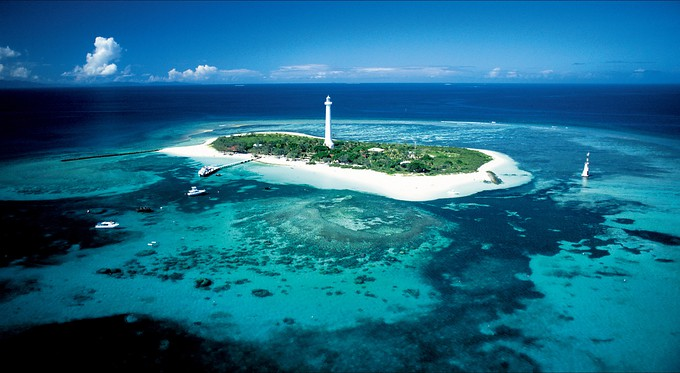
Historical
Circuit
A stoning gothic
cathedral in the tropics. Its construction, undertaken in 1887,
required ten years of hard labor & necessitated the efforts
of ”convicts” and all of the trades people
Living in Nouméa
at the time. The cathedral made of local stone and wood, has two
square towers which are 25 meters in height overlooking the city
of Nouméa.
Situated in the
heart of the “Vallée-des-Colons” you will
discover the jewel in the crown of colonial homes – a
majestic family mansion that belonged to one of the great New
Caledonian families. The Hagen Château was purchased by the
Southern Province in 1998, and it is open to the public for
temporary exhibitions only.
Opened in 1905, it
has more than 90,000 volumes including many important works on
New Caledonia and the Pacific Islands.
Located in Nouville,
with the history of the prison including the Chapel, the Bakery
Museum and cells remains, see Tourist Office.

On
the road…
In
New Caledonia, I think the most interesting thing to do is rent a
car (“Better
be a 4WD”) and
take the road around the mainland.
Roads
are not easy (especially on the East Coast & the ones crossing the
mainland)!
Don’t
be in a hurry and take your time, even if you think the
distances between villages are short (in Km.). Your drive will
take more time than in your country; (e.g.: 300 Km. can take
a minimum of 4hour 30 minutes), so be alert & keep your gas tank always
at half tank. Avoid driving by night and visiting Kanak
villages without the permission of the village chef.
My
suggestion for an adventure trip is to depart from
Nouméa by
the North-West, take
the RT1 in
direction of Paita,
Boulouparis,
La
Foa and
Bourail.
In
Bourail
, visit the rock by
the sea, the “Bohomme
de Bourail”,
afterwards continuing
North always on the RT1
to Poya,
Pouembout, Koné
et Voh.
In
Voh, visit the “Le
Cœur de Voh” (a
huge and natural heart shape located in the mangrove forest of
Voh).
From
Voh,
go back to Koné
& take
the RPN2 (Cross
mainland road) to
Tiwaka
& Wagap
on the East
Coast and the
RPN3 South
to Poindimié.
In
Poindimié
you
will find a nice Motel (by New Caledonia standards); “The
Tiéti Tera”
This
new 3-Star resort is set in 2.7 hectares of woodland and right on
the beach. It offers 3 types of accommodation, including ten
ocean suites on the sea front, spacious and equipped with luxury
amenities, twenty luxury, tropical bungalow-style rooms and
twenty standard, garden-facing rooms.
The
Tiéti Tera Beach Resort
is
located on the biggest and most beautiful beach on the East Coast
of New Caledonia, next
to the village of Poindimié.
The
Tribes from the 3 Valleys and the People of the Sea as they are
known are the guardians of an ancestral culture, a life rich in
emotions and sensations, because, with
the exception of the village of Poindimié, the only
commercial area on the East Coast,
the
surrounding communities live according to nature, abiding by the
teachings of the Elders.
Of
course this is the place to stay for two nights & visit the
wild North East
road
to Hienghène
&
Pouébo.
Tiéti
Tera Beach Resort
Route
RPN3
16
Voie Urbaine N°1
98822
Poindimié
Nouvelle
Calédonie
Tel :
(+687) 42 64 00
Fax :
(+687) 42 64 01
Email :
resa.tieti@tera.nc
www.tera.nc
Next
day take the RPN3
North to
Hienghène
to
visit the wild scenic coast road
and see the Hienghène Bay view point on to the rocks of
“the
hen” (la
poule) and “the
sphinx”.
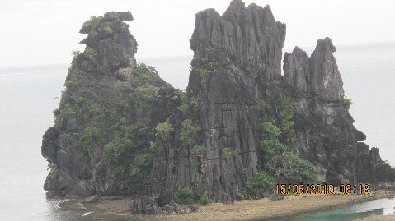
The
Hen Rock at Hienghène Bay Photo ® Freddy Santamaria
After
the nice views of the Hienghène bay, continue North to the
village of Ouaième,
where
the National Road RPN3
is cut by a river bordering
the top mountain of New Caledonia; “The
Mount Panié” (1628
m.), where the “local
legend“ says
that: no
bridge will be built on the river to block the passage of the
spirits from the Mount Panié to the sea.
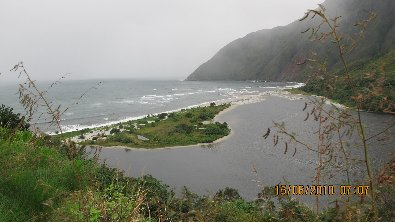
Ouaième
River
Photo ® Freddy Santamaria
In
consequence a “barge” – “Le
Bac de la Ouaième”, was built, running 365 days a
year, 24 hours a day,
with free
passage
of course.
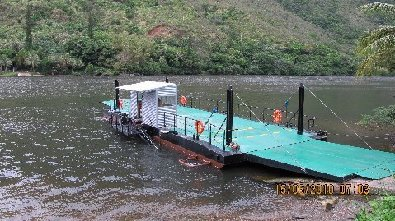
Le
Bac de la Ouaième Photo ® Freddy Santamaria
After
crossing the river, the road is not in very good conditions but
is interesting to continue North the RPN3
to Pouébo
for around 60
Km.
After
this North East tour go back to Poindimié
on
the same day to take a rest, and on the next morning take again
the RPN3
to the South to
visit the villages of: Ponérihouen,
Houaïlou,
Kouaoua
(Lives off the mines, its mineral conveyor is unique in the world
as it is 12 Km. long an can also turn corners)
& Canala,
and do you
have two possibilities
to go back to Nouméa by the mainland cross-roads, the RT3
from Houaîlou
to
Bourail
or the RP5
from Kohto,
Farino et
La
Foa.
It
is advisable to avoid taking the crossroad RP4 from Thio
to
Boulouparis.
And
from La
Foa or
Boulouparis
take the RT1
back to Nouméa.
Another
interesting road trip is a visit to the deep South to Yaté,
leaving
Nouméa
by
the RP1
South to
La
Coulée and
continue by the RP3
to Yaté,
where
you can visit “The
Blue River Provincial Park”, “The
Madeleine Waterfalls & botanical pathway”,
“Goro
Waterfall”, “Japanese
mine ruins (Goro)” &
“The
Yaté dam”.
In
Yaté
you will find also
“The
Kanua Tera Ecolodge” a
nice place to have lunch or stay for the night.
Kanua
Tera Ecolodge
Baie
de Port Boisé
Route
Kaa Nua
B.P.
110
98834
Yaté
Nouvelle
Calédonie
Tel :
(+687) 46 90 00
Fax :
(+687) 46 91 22
Email :
resa.kanua@tera.nc
www.tera.nc
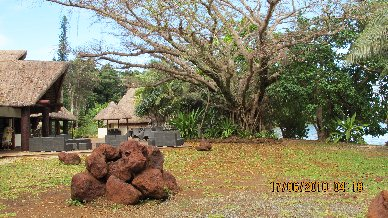
Kanua
Tera Ecolodge Photo ® Freddy Santamaria
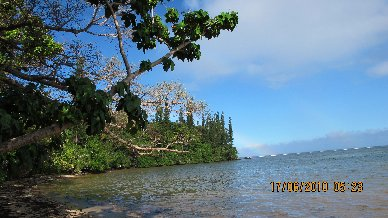
Baie de
Port Boisé Photo ® Freddy Santamaria
From
Yaté
go back to Nouméa
by a secondary road
via Goro
and the second largest nickel processing plant in New Caledonia.
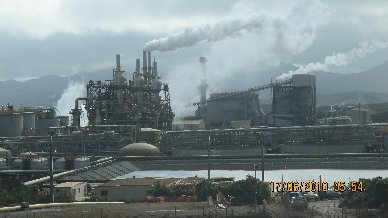
Nickel
Processing Plant Photo ® Freddy Santamaria
The
Islands
The
Isle of Pines (Ile des Pins) – “A taste of paradise”
New
Caledonia is an archipelago of fantasy islands scattered like
beautiful gems in a sparkling sea and the Isle
of Pines is the ‘Jewel of the Pacific’.
Ile
des Pins is just a short 20-minute flight, or 2.5 hour fast-cat
trip from Nouméa with a landscape and culture that makes
it totally unique. In fact, it was named by Captain Cook after he
saw the majestic and distinctive columnar pine trees.

The
island is around 18 km long and 14km wide, with 60km of coastline
and surrounded by its own extensive reef system. It is world
renowned for its unspoilt beauty and truly carefree lifestyle.
Sparkling crystal clear water and glorious fine white sandy
beaches under swaying palms can be found all over the island,
including
Oro Bay
which
has been described as
one of the world’s best undiscovered beaches by the
American travel journal ‘Islands’.
The Isle of Pines is very accommodating, with a range of resorts
and hotels to choose from to suit all budgets, and an excellent
menu of restaurants to suit all tastes.
There
is also so much to see and do. Apart from the obvious selection
of water-based activities, the island has many hidden treasures
that should not be missed. A few days on the Isle of Pines are
something you will never forget.
This
island paradise was discovered by Captain Cook on his epic voyage
in 1774, and European influence began with the arrival of
missionaries during the 1840s, as well as traders in search of
precious sandalwood. In
1872, a penal colony was established on the Isle of Pines and the
ruins of that colony are also worth a visit.
Among
the best hotels on the island:
Ouré
Tera – Beach Resort
Baie
de Kanumera
BP170
98832VAO
– Ile des Pins
Nouvelle
Calédonie
Tel:
(687)431315
Fax:
(687) 431344
Email:
resa.oure@tera.nc
www.tera.nc
Le
Meridien Ile des Pins
Baie
d’ Oro
BP
175
98832
- Ile des Pins
Nouvelle
Calédonie
Tel :
(687) 265000
Fax:
(687) 265100
Email:
le.meridien@meridien.nc
 Loyalty
Islands – Iles Loyauté Loyalty
Islands – Iles Loyauté
Maré,
Lifou
and
Ouvéa
are
a 40 minute flight from Nouméa, and there are several
flights each day on Air Calédonie. The Betico motorized
catamaran also runs services from Nouméa to Lifou, Maré
and Ouvéa several times a week.
Lifou
- The island of many faces
Originally
known as Drehu, Lifou is the largest of the Loyalty Islands,
being 1,150 km2 (larger than Martinique or Tahiti) and the most
populated. Lifou was discovered by the French man Dumont
d’Urville that was quickly followed by dozens of Catholic
and Protestant missionaries.
Ouvéa
- The closest island to paradise
This
island is a dream destination with its magnificent clear blue
sea, white sand beaches and its green parrots which are unique in
the world. The west coast of the island boasts the largest beach
in the Loyalty Islands: 25 km of uninterrupted white sand
surrounded by an emerald lagoon.
Maré
- It speaks to your heart
Maré
Island or Nengoné, with its cliffs high above the waves
below, seems to be the most secret of the Loyalty Islands.
Divided into 8 districts, the island has a wild beauty: decidedly
jagged basalt rocks (remains of the first volcanic activity),
somber forests and long beach’s bordered with coconut
palms. Its central plain is scattered with grottos and natural
pools where fish and turtles swim.
For
more information about the islands : www.office-tourisme.nc
Nouméa
Hotels
By
experience, the best and most convenient hotel in Nouméa:
La
Promenade Hotel Nouméa - Best Western Premier
- 4stars
The
newest hotel in Anse Vata, Nouméa, New Caledonia. It
is a Best Western Premier Hotel located right in the middle of
Anse Vata beach. All
of the apartments have a panoramic view of the lagoon from their
large balconies.
Overlooking
New Caledonia's lagoon and the lovely Anse Vata beach "La
Promenade" Premier Best Western Hotel combines the comfort
of large, modern apartments with the services and facilities of a
4 stars hotel.
The
full sized modern kitchens have the latest, high quality
equipment.
There
is a laundry room, free WiFi or Lan Internet, TV, DVD, and daily
maid service. You'll have everything you need to enjoy your
accommodation, as well as your activities.
Room
descriptions ...
Junior
Studio Suite
Deluxe
One Bedroom Suite
Executive
Two Bedroom Suite
Royale
Three Bedroom Suite
Suite
Deluxe Superieure
Double
Room
Virtual
Tour of La Promenade Hotel
Best
Western Premier la Promenade
109
Promenade Laroque
BP
8142
98807
Nouméa
New
Caledonia
Tel.
: (+687) 24 46 00
Fax
: (+687) 24 47 00
Mail
: resa@lapromenade.nc
Other
Hotels in Nouméa ...
Le
Lagon Hotel

 Ramada
Plaza Noumea Ramada
Plaza Noumea

Le
Pacifique

Nouvata
Parc Hotel

Le
Meridien Noumea

Best
Western Hotel Le Paris
Le
Surf Hotel

Le
Parc

L'Escapade
Island Resort
The
Gourmet Corner
Well,
the truth is there is no Gourmet Corner in New Caledonia,
but
you cannot leave New Caledonia without tasting a “bougna”,
the
traditional Melanesian dish and
it’s definitely worth a try.
Bougna
is
a combination of chicken, lobster or fish with yams, bananas,
sweet potatoes and coconut milk wrapped in banana leaves. The
food is then steamed in an earth oven heated by hot stones.
Bougna is served with a variety of other dishes, including
seafood, coconut milk and tropical fruit.
Difficult
to find on the real way, but you can find it in some restaurants
cooked in a casserole.
Another
interesting specialty dish is Civet
de Rousette or
bat stew,
a favorite with the locals. Other delicacies include small
mangrove oysters (huitres
de paletuviers)
and a pastry filled with seafood and cream sauce (vol-au-vent
des fruits de mer).
Among
the Best restaurants in Nouméa I will mention:
La
Coupole Restaurant Gastronomique
Noumea's most famous
gourmet French restaurant, located on Anse Vata near the Aquarium
– Rocher à la voile.
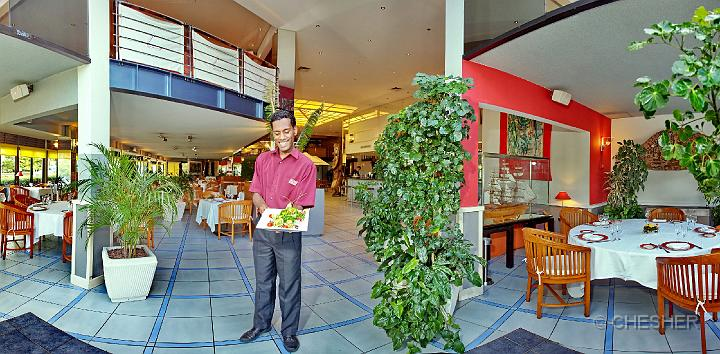
Reservations:
(+687) 26 44 11
Serving Times: 11:30 AM - 1:30 PM Mon-Fri.,
7:00
PM – 10:00 PM on Saturday. Closed
Sunday.
Nightlife
Anse
Vata and Baie des Citrons share Nouméa's favourite
night-spots. You will find bars and restaurants on the
hotel grounds and many more plus discos and two world class
casinos within a short walk down the sea-side promenade.
The
Flag
Up
to 2010 the only flag in official use in New
Caledonia,
an overseas territory of France, was the French
tricolor.
However,
with the official adoption of the Kanak flag alongside the French
tricolor in July 2010,
New Caledonia has become one of the few countries or territories
in the world with two official national flags.

Independence
movement flag obtained official status in July 2010
La
Coutume – (The Custom)
The
Melanesian or Kanak culture, is an ancestral culture of mainly
oral tradition. All of the belief systems and legends are passed
on by the “elders” who, in doing so, perpetuate these
important traditions and customs.
The
custom and the rules of politeness are still alive and well in
the Bush and the islands, and necessitate some propriety.
When
visiting a tribe, you are expected to
“faire
la coutume”, which
means offer the chief a small gift as a sign of respect – a
sarong, cigarettes or a bank note.
Some
places can only be visited once you have requested permission
from their ritual guardian. Any
paths which are barred, even symbolically, should not be used as
they remain the tribe’s property and lead to sacred places.
***************************************
Freddy
Santamaria “The Smooth Operator”
fredmarcom@aol.com
Paris,
France — November 19, 2010
For
EDA Confidential:
www.aycinena.com
Copyright
© 2010— Freddy Santamaria
All rights reserved.
Print Version
|

